Back in 1998 I was able to interview Marcel R.Van Cleemput the former chief designer at Corgi toys, about the some of classic TV and film models that he had designed for the company over the years. This was originally filmed for a sadly aborted video project about 1960’s spy related toys that I was working on. Recently I came across some of my recording from that meeting. So here published for the first time are some extracts from that meeting.
JB: How did you come about choosing which characters you would produce a model vehicle for?
MVC: Well as you know it all started with the very first model The Saint, The Saint Volvo. I can’t really remember why we decided to do that, we’d got a Volvo in the range and of course the programme was quite popular and it was sort of a quick way to get into the market put a label of The Saint on the bonnet and there we were, it proved very successful.
That obviously wets the appetite and you want to do more. So we followed on with other things. At Corgis we were always inventive we were the first with virtually every type of feature on the market. Then we saw The Saint on television and we had a Volvo already in the range we thought it would be a good way to capitalise on the programme, which we did with just adding a label and it was very successful. So after that we had to look around and carry on ding more character merchandise. We were extremely successfully when we started with the James Bond Aston Martin.
JB: I notice this was your next main foray into character merchandise.
MVC: It was the main one the climax if you like it was the icing on the cake, of any cake, we crashed that through , I think a couple of our directors had seen the James Bond film and barely taken too much notice. An article appeared in our local paper about the Aston Martin being made nearby only 15 miles away there was a bid article and I went into the directors and suggested we made a model of the Aston Martin which to cut a long story short we did and that was one of the most successful die cast models ever made. And we then struck up a very, very good relationship with all the Bond people Cubby Broccoli to the extent that the last few films I was involved in we’d get a call from Cubby’s office saying come down to Pinewood Cubby wants to discuss with you what we could do with the next film which we’re about to start shooting. So we were in right at the very beginning. It had to be like that because of the time factor, our main competitors were taking two years from the start of an idea through to getting it on the market, so with the James Bond models. We were by and large taking a year to 13 months and Lesney’s were again taking a long time.
JB: How many headaches did that model course you given the amount of working features you managed to cram into it, the ejector seat etc?
MVC: I don’t know, I don’t remember it as a headache, everything to me was always a challenge anyway, never a headache never a problem I relished in all of it. I was working 18 hours a day probably 10 to 12 hours in the office then the rest of the time thinking about things. Keeping up to date with all the press to do with vehicles and tractors and transport so we could always stay on top, and then once we got the character merchandise we then had to be up to date with all that was going on in the film industry and television.
JB: The other thing about your Aston Martin was I believe that it was the first time there was a genuine toy shortage of them.
MVC: That’s right that was the first time there were lots of instances afterwards. The Aston Martin as you know in the film was silver, we made it gold, because it was Goldfinger, which just seemed a nice touch. I don’t think it would have affected sales if it had been silver. Actually I’m pretty sure the fact that it was gold we sold far more, than had it been silver. It just a nice touch I think.
JB: The next models were the Avengers set, now was this once again a case of having the models already in the range?
MVC: Well yes we already had the Bentley, I think we had the lotus as well. But that was a very popular series on television. In the series it was green and our model was red, because we’d already got a green Bentley in our classics range and I think just to put it green in with that would have reduced our sales considerably because kids would have said well I’ve got the green Bentley. You have to, it’s like an artist’s licence like painters do.
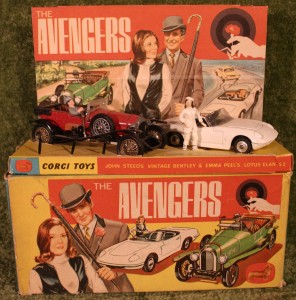
JB: I was going to ask about that, I understand that early issues of the set did contain a green Bentley.
MVC: We were in Northampton were all the design and development tooling were done, production was in Swansea and sometimes Swansea production if they were short of a colour paint would to expedite things would do a few things we didn’t know about until it was too late . I remember them doing a Mercedes in a mauve colour awful lilac mauve colour and it wasn’t realised until our German representatives brought us really stinking letter and irate phone calls how can you do a Mercedes in this colour and it was because they’d run out of the colour we’d wanted and they were trying to cut the costs and use any paint they could find in the factory. So things like that did happen, but we weren’t supposed to know about it. We issued a specification sheet for each job denoting colour and everything and it should have been abided by.
JB: Moving onto the U.N.C.L.E. car also issued in 1966, and there were both a blue and a white version issued.
MVC: Yes you don’t see many of the white version.
JB: With its Waverly ring.
MVC: Yes that was a nice gimmick.
JB: Now U.N.C.L.E. must have been a show where you were quite limited with what you could do, with the cars gimmicks.
MVC: That’s right and we needed something we could get out quickly. So we used an existing car and the operating of the gun was quite a simple gimmick really but quite effective.
JB: Presumably this was why we had the addition of the ring to add a little bit more value. The other big model of ‘66 was the Batmobile
MVC: Well the Batmobile when we started that, it wasn’t really know in this country it was really for the American market. And our American agents really wanted something for the American market, they’d seen how successful we were with the Bond models and all the others so our director who was in the States came back with information and we crashed it in, it worked really well because after we had the Batboat, and the Batcopter .
JB: Like the Aston Martin that stayed in your range.
MVC: Yes our second biggest seller I think.
JB: In 1967 we had a return to the Bond movies again with the Toyota.
MVC: Yes there wasn’t really very much we could do with that. I mean we did the best we could the firing of the missiles from the back. It was a nice little model. With its little 007 pendent and jewelled headlights.
JB: Now I believe Corgi were the first to introduce them.
MVC: Yes first with virtually any gimmick you could mention
JB: Now I’m interested with the missiles in the rear I believe they had originally intended to have this feature to the car in the film, but then didn’t use it.
MVC: I wouldn’t like to comment on that we just had to find a gimmick to make it exciting for kids as a play thing rather than just zoom it along. I don’t remember the film if it did anything. But it’s something that would have been agreed with the Bond people , they would have said go ahead and do it, as they were very keen to have us produce all these models as it also drummed up interest in the movies.
JB: Also in 67 we have the Green Hornet
MVC: That was another typical American film that hadn’t been seen over here when the model was released. It still did quite well. It was a very attractive model with the green headlights it fired the missile at the front shot of this spinner at the back.
JB: With models like these with the working features typically how many components would go into one of these vehicles?
MVC: I would think you’ve got about 30 to 35 components in there, it added to the production cost, but they still sold for a very reasonable price compared to Corgi models issued today.
JB: In 1968 you returned to another issue of the Aston Martin.
MVC: This this was slightly bigger at 43rd scale.
JB: This is my personal favourite issue of the model you’d added some extra features to it.
MVC: Yes the tyre slashers at the back and the revolving number plate. Along with a sheet of stickers so you could put the number plates on, yes that was probably the nicest size, of course we did a bigger one again later on. We changed everything to 36th scale, because you had the same amount of parts, labour, assembly yet because it was quite a bit bigger hopefully you could charge more for it, the percentage of extra metal is probably only around 10 percent of the cost if that probably only 5 percent but you could ask a lot more for it. Probably around maybe 30 to 40 percent.
JB: Also around this time a lot of your range was being reissued with whizz wheels
MVC: Well that was because the Americans had come onto the scene, trying to get one over on us which they did with whizz wheels. I mean they cut very thin axels so they ran much further. So we went in changed our axels
JB: I feel this lead to your models looking less attractive what are your thoughts on this
MVC: Well I was a purist so I wasn’t really in favour of this but you have to go along with the market and market force. I never liked whizz wheels.
JB: What can you tell me about the Husky and Corgi Jnr ranges?
MVC: Well I had some involvement with it., but it was more a very high level decision to go to Woolworths. I think our directors had very good relations with Woolworths and I think they thought that’s the way to start selling the range to combat matchbox obviously but I think in the end they realised they could do far more by giving it the name Corgi Jnr and celebrate on the brand name Corgi which I think did have a lot more going for it.
JB: Several items in this range were of particular interest the UNCLE Piranha sport car being one I was always interested that you did it in this range but never in the larger range.
MVC: Well you see we were trying to produce two new models a month and in the Jnr range we were producing two a month and that’s a hell of a load on design capacity pattern making model making and tooling capacity. Production had a job to keep up with demand sometime you just think we can’t do this so it went to Jnr instead. We just couldn’t make everything I wish we could but… there’s a lot of hours work in just designing that. You’re talking about 3 weeks work for a designer and if you’re doing 4 models a month that’s 15 designers you need and we didn’t have 15 designers we had chaps who worked very, very hard. 12 hours a day wasn’t unknown. You’d come in at half 7 or 7 o’clock in the morning and sometimes nip home if you didn’t live too far away for some dinner at 5 then come back and work until 9 o’clock. It the only way we coped.
JB: Presumably this is why the Husky Corgi Jnr Bond Aston is a different Mk of Aston to those used in the films
MVC: Yes, we couldn’t afford to keep tooling these things, so an existing model from the range was adapted. In those days every Corgi model cost £50,000 to £60,000 to tool. You’re doing 4 a month and that’s £250,000.
JB: That’s a fair few sales if you’re only selling them for a few shillings each. When the Husky range became Corgi Jnr you had the next influx of James Bond models for the film OHMSS, you didn’t actually have any models in the main range.
MVC: They all came from the original models in the film. I remember photographing those. That was a very successful film. The VW that was in the film with Corgi advertising also in the film you can see along the ice rink Corgi advertising publicity banners that was all agreed with the film company beforehand. Mutual co-operation.
JB: The other models to emerge from the film were the Corgi Rockets, what can you tell us about the origins of the Corgi rockets range?
MVC: Again this was a reaction against Mattel Hotwheels. We were doing all this character merchandise for virtually no royalties. Mattel Hotwheels came along and they started offering $250,000 upfront for character licences. Which then killed everything because we were starting to decline a bit the main reason for that people should be aware that we could sell them to kids up to the age of 15 -16 I know that for a fact as we had the Corgi Club and you look at that and a lot of the Corgi members were between 12 and up to 16. We used to have letters from them and we were so successful that everybody in the die cast business tried to get in on the band waggon so there were a lot of French companies a lot of Japanese from everywhere the Germans Teckno, the Italians Pepe toys everybody got in on the band waggon so we were now sharing the market with everybody else but over the years in the seventies I personally would not have given a Corgi toy to a child of 11. So we had lost the market up to the age of 15. We also lost the early age gap kids were buying large plastic toys by Fisher Price. So the age gap for die-cast toys was now 6 – 10. Now shared with about 30 companies. So then you can’t afford to put $250,000 up front for royalties.
JB: The nice thing about Rockets was there extra feature of inter changeable chassis and tune up key.
MVC: Again we had to find something Mattel weren’t doing. You always had to think ahead.
JB: Now in your Corgi Rockets range was an Aston Martin of the type used in OHMSS but this was never issued as a Bond model were there any reasons for this.
MVC: Down to production capacity, being a Bond model would probably mean having to produce around 100,000, and we just did not have the production capacity at the time. You can only run your moulds at a certain speed and you can’t get any more out of your moulds than say 2 to 300 models an hour.
JB: That’s a fair number per hour, I didn’t realise they ran as many as that out of a mould in an hour.
MVC: I used to get calls to go to meetings with Cubby and Ken Adams who was the designer to discuss what models we could make in the films that were about to start shooting the moon buggy was in the film and was quite a successful model. Co-operation between the Bond people Cubby Broccoli and ourselves very good rapport and relationship so much so that I was able to run a completion at our local village fete and the prize, the winning ticket was for a young lad to visit the film studio which he did and when we were there they were filming Octopussy and they said well you take him in the big top and you can actually see him in the film , that was one aspect, the other thing was when I was called down they use to ask me for any input I may have for future films and one of them was for this Jaguar with an ejector rear which they liked very much, it was put on hold it may still appear one day in a film and if so I shall be asking for my royalties, but it was an excellent, excellent relationship all the way through.
JB: Another of your seventies models was the flying car.
MVC: Ah yes I think there was an article in one in the press. I think there was a flying car being made in America and I thought this would be a nice model to make. I can’t remember which came first I know we produced the model, I think we produced it for the James Bond film.
JB: I’ve never come across one in Bond packaging.
MVC: It was in the Corgi Jnr range wasn’t it, I’m not quite sure whether we put it out under a James Bond image or not, but if we didn’t we should have done shouldn’t we. Somebody must have been asleep at that time, but once again it was probably all down to capacity at the time.
JB: Of all the models you designed over the year did you have a favourite
MVC: I think the one I enjoyed most was the Lotus Esprit with the fins that came out because it was such a small compact model to get all those features in side I know I came back from the studio and I think it’s in the book, I actually worked out the mechanism on the steering wheel driving back up the M1 and I gave this sketch to my designers and said that’s what we want I’m quite pleased with that one.
JB: That’s certainly one of the most inventive models of that period as you seemed to be becoming more limited with what you could do for safety reasons.
MVC: Yes we had all sorts of gages as to the size of parts, for dangerous parts. if you could have seen the factory at that time running at full speed, the die-cast machines in like a vast hanger producing castings that needed to be cleaned fettled painted that was a job in its self, painting them, painting all the different castings in the various colours required and the assembly lines probably 500 ladies on the assembly lines assembling them.
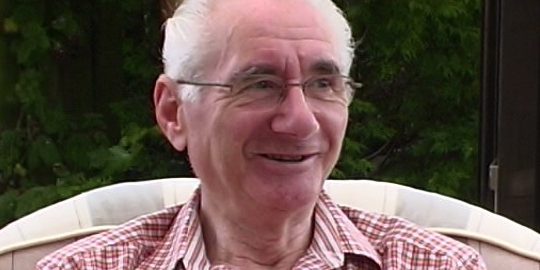











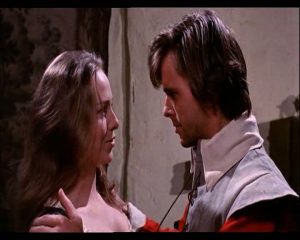
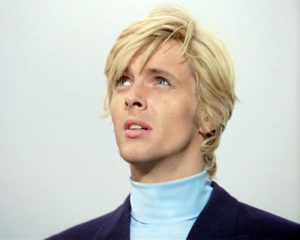 IO- (chuckles) Well, I was 21 or 22 and I didn’t think about things like that, I just thought did I look nice with my blond hair and decided I didn’t really. Of course, “The Avengers” is one of those shows which was so stylized. You know, there was no attempt at realism. I suppose they had an influence to a certain extent, but I would have thought frankly it was the other way round – television doesn’t often create, it often follows style, rather than create it.
IO- (chuckles) Well, I was 21 or 22 and I didn’t think about things like that, I just thought did I look nice with my blond hair and decided I didn’t really. Of course, “The Avengers” is one of those shows which was so stylized. You know, there was no attempt at realism. I suppose they had an influence to a certain extent, but I would have thought frankly it was the other way round – television doesn’t often create, it often follows style, rather than create it.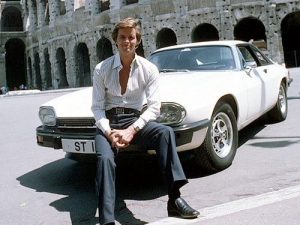 IO- My agent called me to say that Bob Baker thought I’d be good to take over from Roger Moore in “The Saint”. It had been off the air for several years. I thought, “Oh, right, really.” It turned out his wife had seen me in “Upstairs, Downstairs” and it was odd really because the two characters of the Saint and the character I play in “Upstairs, Downstairs” could not have been more different. But the reason was, of course, that I looked a bit like Roger, there’s no denying it, and so it was on that basis, Then I didn’t hear anything at all, because Bob Baker said he hadn’t yet got the green light for it at all, he’d got to persuade his boss, Lew Grade, and it took him another six or seven years. Then all of a sudden my agent said you’ve been offered “The Saint”. I went, “Great!” and that’s how easy it was. I never did an audition, I never read for it, I just had a meeting with him one year, then all those years later the offer was there. Which is the best kind of work, isn’t it.
IO- My agent called me to say that Bob Baker thought I’d be good to take over from Roger Moore in “The Saint”. It had been off the air for several years. I thought, “Oh, right, really.” It turned out his wife had seen me in “Upstairs, Downstairs” and it was odd really because the two characters of the Saint and the character I play in “Upstairs, Downstairs” could not have been more different. But the reason was, of course, that I looked a bit like Roger, there’s no denying it, and so it was on that basis, Then I didn’t hear anything at all, because Bob Baker said he hadn’t yet got the green light for it at all, he’d got to persuade his boss, Lew Grade, and it took him another six or seven years. Then all of a sudden my agent said you’ve been offered “The Saint”. I went, “Great!” and that’s how easy it was. I never did an audition, I never read for it, I just had a meeting with him one year, then all those years later the offer was there. Which is the best kind of work, isn’t it.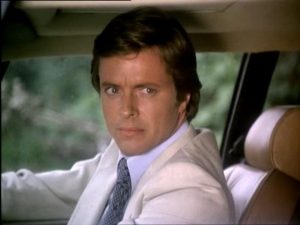 IO- Hmm, I know, a bit bizarre wasn’t it!
IO- Hmm, I know, a bit bizarre wasn’t it!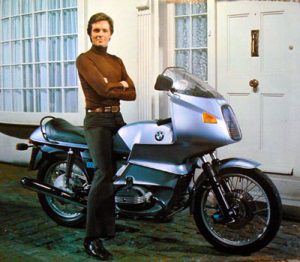 IO- Yes, I learnt Scuba diving on “The Saint” actually. I was taught that, but horse riding I’d done since I was a little boy. We did a skiing episode and they said to me, “You are absolutely not allowed to move on the insistence of the insurance company, you just have to stand there.” But after a while I got bored and said to the assistant director, “How long are you going to be on the set up for the next shot?” He said an hour, so I said how about if I just went off quietly, if I promise to be back in half an hour, and he said, “I didn’t hear you say that Ian, bye”. And I started skiing again, but very very quietly as I shouldn’t have been doing it. Little things like that. And riding horses that’s true. You know it’s always amused me about the Saint that he could drive any car, he could ride a motorcycle … I put the motorcycle in by the way. I said to Bob, “You’ve got to have a motorbike in this.” I suggested it to him and he went, “Yeah alright.” But he didn’t really approve. Silver BMW, I put that in, in fact I still have a motorcycle in California; I ride it sometimes, enormous great thing, my toy.
IO- Yes, I learnt Scuba diving on “The Saint” actually. I was taught that, but horse riding I’d done since I was a little boy. We did a skiing episode and they said to me, “You are absolutely not allowed to move on the insistence of the insurance company, you just have to stand there.” But after a while I got bored and said to the assistant director, “How long are you going to be on the set up for the next shot?” He said an hour, so I said how about if I just went off quietly, if I promise to be back in half an hour, and he said, “I didn’t hear you say that Ian, bye”. And I started skiing again, but very very quietly as I shouldn’t have been doing it. Little things like that. And riding horses that’s true. You know it’s always amused me about the Saint that he could drive any car, he could ride a motorcycle … I put the motorcycle in by the way. I said to Bob, “You’ve got to have a motorbike in this.” I suggested it to him and he went, “Yeah alright.” But he didn’t really approve. Silver BMW, I put that in, in fact I still have a motorcycle in California; I ride it sometimes, enormous great thing, my toy. 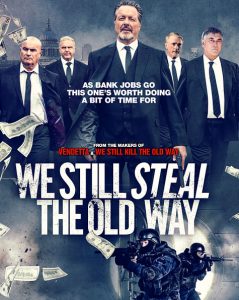 IO– I did “We Still Kill The Old Way” two years ago and last year we did the sequel “We Still Steal The Old Way”.
IO– I did “We Still Kill The Old Way” two years ago and last year we did the sequel “We Still Steal The Old Way”.